Reverse ATMs -- also known as "cash-to-card kiosks" -- are a groundbreaking advancement in cash handling that are reshaping the financial landscape. As we navigate through this era of digital transformation, companies who choose to implement this technology are confronting a series of challenges ranging from user education to security enhancements and regulatory compliance. Here, we will discuss these challenges, offering a comprehensive view of how organizations can seamlessly integrate this innovative technology into their businesses to not only enhance customer experience but also stay ahead in their respective industries.

Challenge 1: Educating Users
- Extensive Training: Introducing reverse ATMs requires educating both customers and staff thoroughly about the technology and its transaction capabilities.
- Easily Accessible Learning Tools: Smooth transition to new technology necessitates user guides, online tutorials, and videos, accessible on the company's website.
- On-Site Assistance: Offering live support with trained staff to assist users with cash-to-card kiosk transactions, especially during the first few weeks or months post-implementation, can greatly improve adoption rates.
- Highlighting Benefits: Communicating the advantages of reverse ATMs—like convenience and eco-friendliness—encourages more users to embrace the technology.
Challenge 2: Ensuring Transaction Security
- Robust Security Protocols: Companies must employ a multi-layered security strategy, including data encryption, for secure reverse ATM transactions.
- Advanced Identity Verification: Adding biometric authentication like fingerprint or facial recognition to reverse ATMs enhances security.
- Ongoing Security Maintenance: Regular security checks and timely updates are crucial for keeping ahead of threats.
- Clear Communication on Security: Businesses need to openly discuss reverse ATM security features with customers to build trust.

Challenge 3: Consistent Maintenance and Support
- Routine Maintenance: Regular inspections and updates are vital for the continuous operation of reverse ATMs.
- Specialized Staff Training: Training staff specifically for reverse ATM maintenance ensures prompt issue resolution.
- Real-Time Problem Detection: Businesses should use remote monitoring to quickly identify and solve problems, ensuring uninterrupted service.
- Vendor Collaboration: Working with reverse ATM vendors for support and maintenance brings expert assistance and knowledge.
Challenge 4: Adhering to Regulations
- Constant Regulation Monitoring: Businesses need to vigilantly track changes in regulations regarding cash-to-card transactions.
- Working with Regulators: Open communication with regulatory bodies is key for guidance and compliance assurance.
- Regular Compliance Checks: Internal audits help identify and rectify regulatory shortfalls, avoiding legal issues.
- Accurate Record-Keeping: Documenting reverse ATM transactions and compliance efforts is essential for audits or regulatory inquiries.
In summary, to fully leverage reverse ATMs, companies must invest in comprehensive technological integration -- like that offered by REDYREF -- as well as user education, advanced security, consistent maintenance, and strict regulatory compliance. These initiatives ensure a secure, efficient, and user-friendly experience, aligning these financial services with the digital era's demands.
In today's fast-paced, digital world, convenience and efficiency are key factors that drive consumer preferences. Cashless transactions, credit cards, and mobile payment apps have become the norm, but the need for access to physical currency remains. Many businesses are embracing a fascinating new trend – reverse ATMs, also known as cash-to-card kiosks. These innovative kiosk machines allow customers to convert cash into prepaid cards, opening up a world of opportunities across any number of industries.
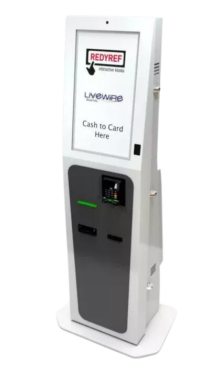
Businesses That May Benefit from Reverse ATMs
Reverse ATMs are revolutionizing the way customers interact with businesses. These kiosks take the traditional ATM concept and flip it, providing an alternative solution for cash handling. Instead of withdrawing cash, customers can load their physical currency onto a prepaid card. The process is straightforward and user-friendly, making it an attractive option for many different types of businesses, including:
- Amusement Parks and Entertainment Venues: Amusement parks, water parks, and entertainment venues often deal with large crowds and significant cash transactions. Cash-to-card kiosks can simplify the process of converting cash into prepaid cards for use within the park, reducing the need for carrying and handling physical cash.
- Casinos and Gaming Centers: Casinos handle substantial amounts of cash daily. Cash-to-card kiosks offer a secure and efficient way for patrons to convert their cash into gaming credits on prepaid cards, enhancing the overall customer experience.
- Event and Concert Venues: Large events and concert venues can streamline ticket sales and concessions by offering prepaid cards that customers can load with cash at kiosks. This reduces wait times and minimizes the need for cash handling at these venues.
- Malls and Shopping Centers: Shopping centers can integrate cash-to-card kiosks as a convenient way for shoppers to convert cash into mall-specific gift cards or prepaid cards that can be used at various stores within the mall.
- Public Transportation: Public transportation systems can use cash-to-card kiosks to allow commuters to load cash onto cards for convenient use in buses, subways, or trams. This eliminates the need for exact change and speeds up the boarding process.
- Universities and Campuses: Educational institutions can offer students prepaid cards for use in on-campus facilities, such as cafeterias, bookstores, and laundry services. Cash-to-card kiosks can be strategically placed to enhance the student experience.
- Hospitals and Healthcare Facilities: Healthcare facilities can use reverse ATMs to provide patients, visitors, and staff with prepaid cards for use in hospital cafeterias, parking, and vending machines. This minimizes the handling of cash in medical environments.
- Restaurants and Food Chains: Restaurants, particularly those in high-traffic locations, can offer prepaid cards that customers can load with cash at cash-to-card kiosks. This approach streamlines transactions and can be linked to loyalty or rewards programs.
- Hotels and Resorts: Hotels and resorts can provide guests with prepaid cards for use in on-site restaurants, bars, and amenities. Cash-to-card kiosks can be placed in lobbies for easy access.
- Convenience Stores: Convenience stores can install cash-to-card kiosks to allow customers to convert cash into prepaid cards, making it more convenient for purchases and eliminating the need for loose change.
- Airports: Airports can use reverse ATMs to offer travelers prepaid cards for airport dining, shopping, and transportation services. This enhances the airport experience and reduces the reliance on cash.
- Government Facilities: Government agencies can implement cash-to-card kiosks to facilitate payments for services, fines, and fees. This streamlines transactions and ensures secure payments.
- Retail Stores: Retailers can incorporate cash-to-card kiosks, allowing customers to convert cash into store-specific gift cards or prepaid cards that encourage repeat business.
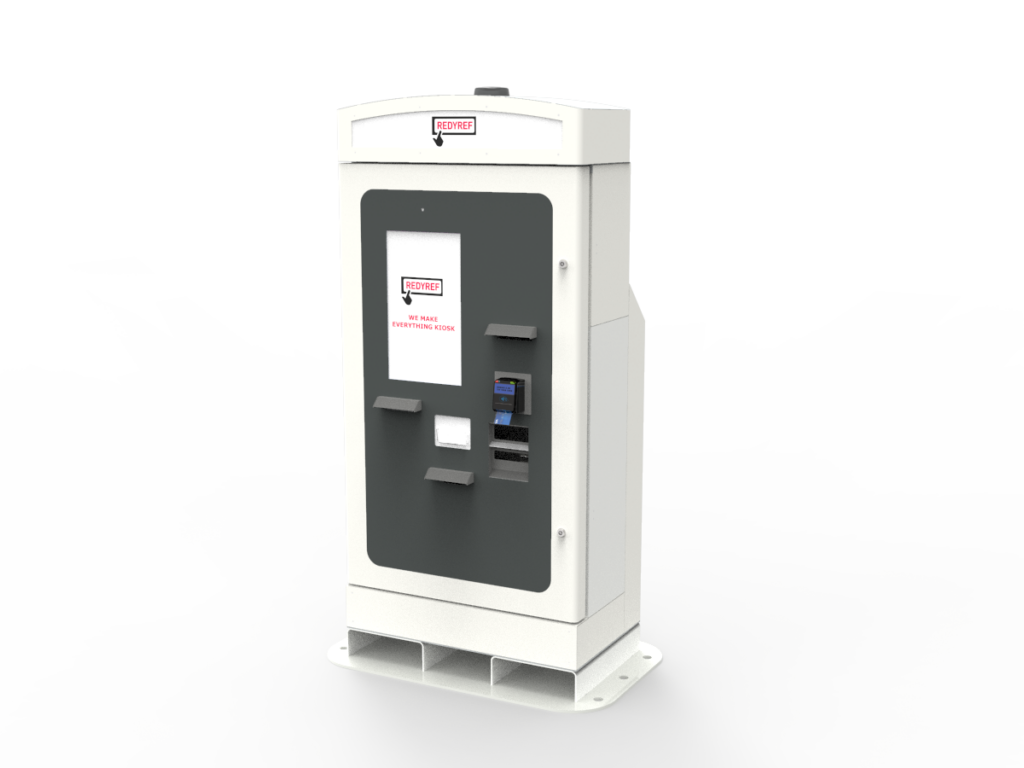
The versatility of
cash-to-card kiosks makes them suitable for numerous business types, enhancing customer experiences, streamlining operations, and reducing cash-related risks. The specific implementation can be tailored to each business's unique needs and objectives.
Benefits of Reverse ATMs for Your Business:
- Enhanced Customer Experience: Reverse ATMs offer a convenient and user-friendly solution for your customers. These kiosks make it easy to convert cash into a prepaid card, enhancing their overall experience with your business. This streamlined process encourages customer satisfaction and repeat visits.
- Reduced Cash Handling: Businesses that traditionally deal with significant amounts of cash, such as amusement parks, casinos, and event venues, face various challenges related to cash handling. Cash-to-card kiosks help minimize these challenges by reducing the need for physical cash. This, in turn, lowers the risk of theft and human error associated with cash management.
- Integration with Loyalty Programs: Some reverse ATMs can be seamlessly integrated with loyalty programs. Businesses can offer discounts, rewards, or bonus points to customers who use the cash-to-card service. This incentivizes the use of prepaid cards, increasing customer engagement and loyalty.
- Access to Unbanked or Underbanked Populations: Cash-to-card kiosks can serve as a valuable financial resource in areas with limited access to traditional banking services. By providing a means to load cash onto prepaid cards, businesses can contribute to financial inclusion and offer solutions to unbanked or underbanked populations.
- Cost-Effective Solution: Implementing a reverse ATM system can be a cost-effective solution for businesses aiming to streamline their cash management processes. Operating costs are often lower than those associated with traditional ATMs, allowing businesses to improve financial efficiency.
- Competitive Edge: By offering innovative services like cash-to-card kiosks, your business can distinguish itself in a competitive marketplace. Staying ahead of the curve and providing customers with forward-thinking solutions can give you a distinct competitive advantage.
Reverse ATMs are changing the landscape of financial transactions for the better. These cash-to-card kiosks provide businesses with opportunities to enhance the customer experience, reduce cash handling risks, integrate loyalty programs, reach unbanked populations, and gain a competitive edge in their respective industries. By embracing this trend, your business can not only adapt to evolving consumer preferences but also contribute to a more efficient and inclusive financial ecosystem. Interested in learning more about reverse ATMs? We are here to help. Send us a message or get a quote online today.
Outdoor adventures like trips to parks, exploration of nature conservatories, and visits to zoos offer a much-needed escape from jobs and school, where we are forced by necessity to stay inside most of the time. To make these experiences more interesting and engaging, many organizations have started investing in outdoor information kiosks.
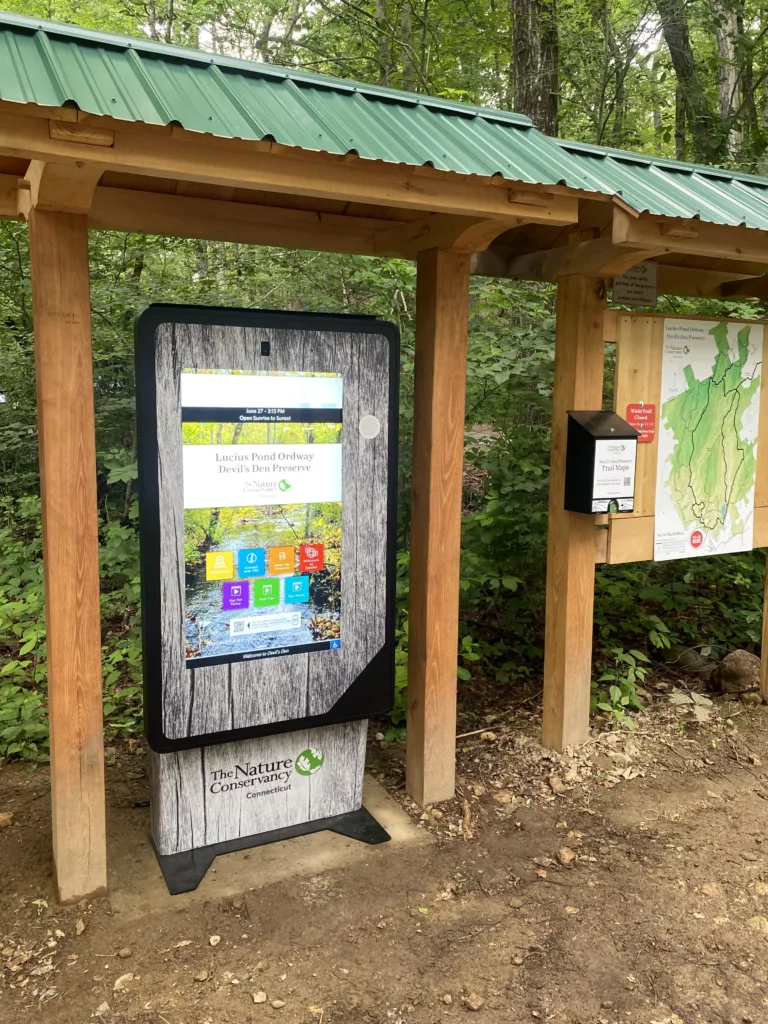
Outdoor Information Kiosks: A Gateway to Nature
Imagine strolling through a lush forest, exploring a wildlife sanctuary, or gazing at magnificent creatures in a zoo. These outdoor experiences can be made even more enriching with the presence of outdoor information kiosks across many different environments.
Parks and Recreation
Whether you're hiking, picnicking, or simply enjoying the serenity of a park, information kiosks can play a role. They provide maps, trail information, safety guidelines, and educational content about the park's flora and fauna. Visitors can better plan their activities and gain a deeper understanding of the park's ecological significance.
Nature Conservatories
For those passionate about biodiversity and conservation, nature conservatories offer a glimpse into the wonders of the natural world. Outdoor kiosks help visitors identify different species of plants and animals, learn about ongoing conservation efforts, and understand the importance of preserving these delicate ecosystems.
Zoos and Wildlife Sanctuaries
Zoos and wildlife sanctuaries are dedicated to wildlife education and conservation. Outdoor information kiosks provide detailed descriptions of each animal species, their habitats, and their conservation status. Interactive kiosks may even offer fun quizzes and educational games for younger visitors.
Key Features of Outdoor Information Kiosks
These kiosks are specially designed to withstand the rigors of outdoor environments and undergo rigorous testing to ensure that they remain fully functional for many years to come.
- Weather Resistance: These kiosks are built to endure rain, snow, intense sunlight, and extreme temperatures. Robust, weather-sealed enclosures protect the sensitive electronic components within.
- Touchscreen Technology: User-friendly touchscreens enable visitors to navigate through maps, educational content, and multimedia presentations with ease. Some kiosks offer multilingual options to cater to a diverse audience.
- Interactive Maps: Detailed interactive maps help visitors plan their routes, locate points of interest, and discover hidden gems within the outdoor area. Users can zoom in on specific regions and access real-time updates.
- Educational Content: Informative videos, images, and text provide valuable insights into the natural environment, historical significance, and ongoing conservation efforts. Kiosks foster a sense of wonder and learning.
- Emergency Information: In case of emergencies or unexpected situations, outdoor information kiosks can display safety instructions, contact information, and guidelines for seeking assistance.
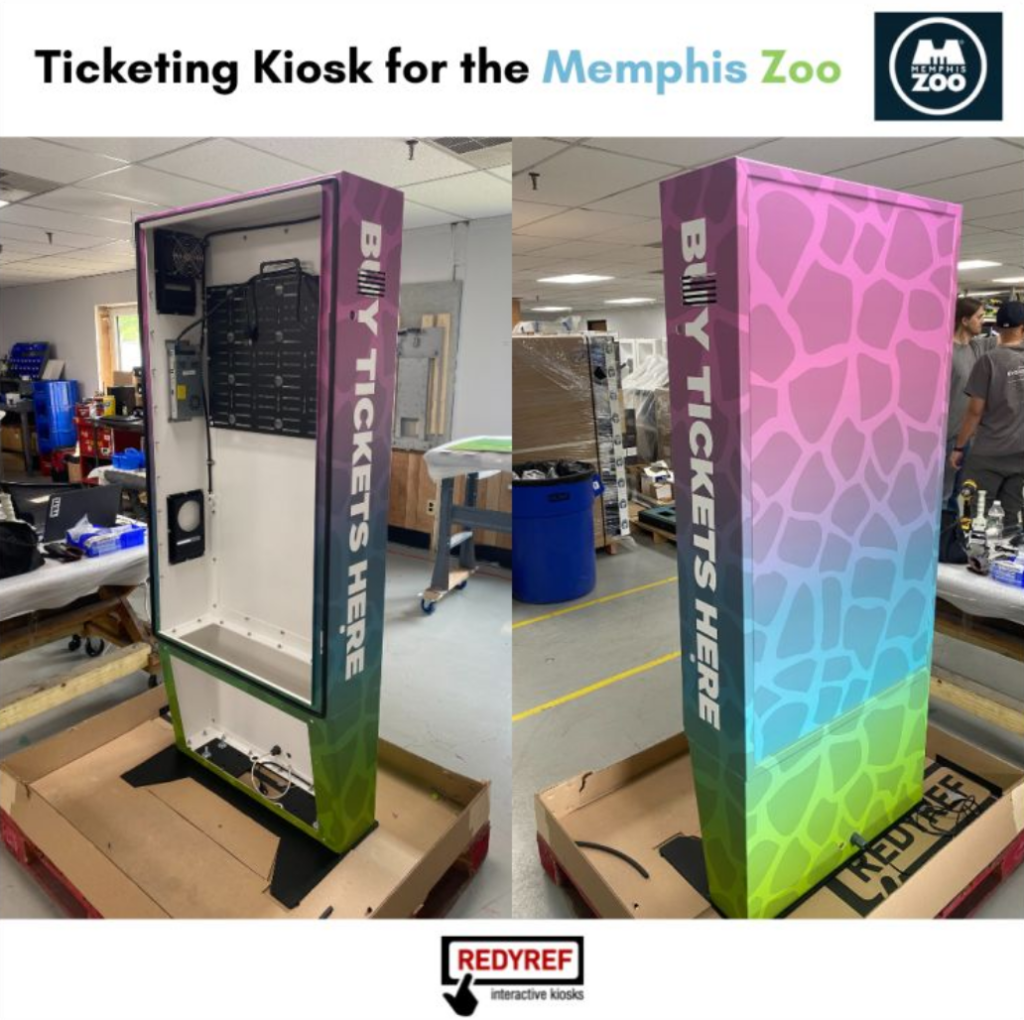
The Future of Outdoor Information Kiosks
As technology continues to advance, outdoor information kiosks are evolving to offer even more engaging and immersive experiences:
- Augmented Reality (AR): Imagine standing in front of a rare bird in a wildlife sanctuary and using your smartphone to access an AR experience that provides real-time information about the species.
- Environmental Sensors: Kiosks equipped with environmental sensors can provide data on air quality, temperature, and wildlife behavior, enhancing visitors' understanding of the natural world.
- Community Engagement: Outdoor kiosks may also facilitate community engagement, encouraging visitors to participate in citizen science projects, report wildlife sightings, and contribute to conservation efforts.
- Transactional Capabilities: Many outdoor kiosks, like those manufactured by REDYREF, can be integrated with components like credit card readers and ticket printers to enable visitors to not only access information, but also pay for and print tickets for the venue.
Outdoor information kiosks are not just a way for guests to learn more about their environments; they can also serve as gateways to the natural world. In parks, nature conservatories, zoos, and similar environments, these kiosks can foster a deeper connection between visitors and the great outdoors. As they continue to evolve, they will continue to play a pivotal role in educating, inspiring, and preserving our planet's natural treasures for generations to come. Ready to learn more about outdoor information kiosks? Learn more or request a quote today!
Business environments increasingly require efficient and streamlined communication channels. Conference rooms, serving as hubs for collaboration and decision-making, play a crucial role in many of these environments. That's where digital conference room signage steps in, revolutionizing the way we manage and optimize these spaces. But what are the features, benefits, and use cases of digital conference room signs, and why should you consider investing in them for your company?
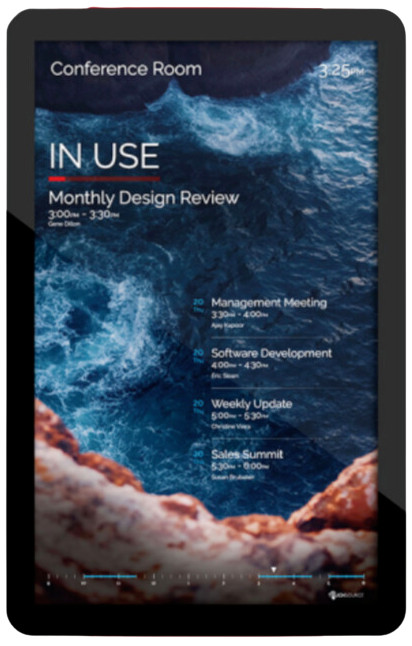
Features of Digital Conference Room Signage
- Real-time Scheduling: One of the standout features of digital conference room signage is its ability to display up-to-the-minute schedules. This ensures that employees always have access to the most current information, reducing scheduling conflicts and wasted time.
- Interactive Touchscreen: Interactive conference room signs allow users to check room availability, book a room on the spot, or extend a meeting if needed. This level of interactivity enhances user engagement and simplifies the booking process.
- Customizable Displays: Tailor your conference room signage to align with your company's branding and aesthetics. Choose from various display sizes, layouts, and themes to create a cohesive and visually appealing look.
- Integration Capabilities: Seamlessly integrate your digital signage with popular calendar applications like Microsoft Outlook or Google Calendar. This ensures that bookings and updates made in these applications are instantly reflected on the conference room signs.
- Wayfinding and Mapping: Larger office spaces can benefit from wayfinding features, guiding employees and visitors to their designated meeting rooms. Interactive maps make navigation a breeze.

Benefits of Digital Conference Room Signs
- Efficient Room Management: Keep conference rooms organized and maximize their utilization. Digital signage automates the scheduling process, reducing conflicts and ensuring that rooms are used to their full potential.
- Enhanced User Experience: Users can quickly identify available rooms and book them with ease. Interactive features empower employees to make on-the-spot decisions, improving overall user satisfaction.
- Time and Cost Savings: Say goodbye to paper-based scheduling and manual updates. Digital signage streamlines administrative tasks, saving time and reducing overhead costs.
- Reduced Interruptions: Conference room signs display clear occupancy status, minimizing disruptions during meetings. No more awkward encounters or double-booked rooms.
- Increased Accountability: Detailed scheduling records provide valuable insights into room usage patterns. This data can help optimize office layouts and identify areas for improvement.
Use Cases for Digital Conference Room Signage
- Corporate Offices: In large corporate settings, digital conference room signage ensures efficient room allocation, minimizes booking conflicts, and simplifies navigation for employees and visitors.
- Hoteling and Flexible Workspaces: In flexible office environments, employees can reserve conference rooms on-demand, enhancing productivity and collaboration.
- Educational Institutions: Schools and universities use digital conference room signage to schedule classrooms, lecture halls, and meeting spaces, streamlining academic activities.
- Healthcare Facilities: Hospitals and clinics employ digital signage to manage appointment schedules, reducing patient wait times and improving the overall patient experience.
- Hospitality: Hotels and event venues utilize conference room signs to keep guests informed about meeting and event schedules, enhancing their stay.
Digital conference room signage can be a game-changing technology and an invaluable asset for those organizations striving to enhance efficiency, productivity, and employee and visitor satisfaction. Ready to learn more? Contact REDYREF today!
To withstand the rigors of outdoor conditions, digital outdoor kiosks must be designed, engineered, and tested to ensure they can endure almost any weather condition while delivering optimal performance. But what makes these kiosks able to withstand so many different climates and conditions?
Understanding the Importance of Weatherproofing Outdoor Kiosks
Weatherproofing is a critical aspect of outdoor digital kiosk manufacturing. This process involves fortifying the kiosk against harsh weather conditions, temperature extremes, and exposure to the elements. Effective weatherproofing -- including waterproofing -- not only protects the internal components but also extends the lifespan of the kiosk, ensuring reliable operation for years to come.

Outdoor Digital Kiosk Weatherproofing Standards
Ingress Protection (IP) Ratings
IP ratings are standardized measures that indicate a kiosk's resistance to dust and moisture ingress. The rating consists of two numbers, with the first representing protection against solid particles (e.g., dust) and the second indicating resistance to liquids (e.g., water).
For digital outdoor kiosks, a high IP rating is essential. Common IP ratings for outdoor kiosks include IP65, IP66, and even IP67, which offer varying degrees of protection against dust and water.
NEMA Ratings
The National Electrical Manufacturers Association (NEMA) also provides ratings that classify the level of protection a kiosk offers against environmental factors. NEMA ratings encompass a broader range of environmental challenges beyond dust and water, including corrosive agents and ice.
NEMA 4X, NEMA 6P, and NEMA 12 are commonly applicable ratings for outdoor kiosks, depending on the specific environmental demands.
Environmental Testing Standards
Various organizations and standards bodies have established specific testing procedures to evaluate outdoor kiosk resilience. For example, MIL-STD-810G is a military standard that outlines methods for testing equipment in harsh environmental conditions, including extreme temperatures, humidity, and vibration.
Testing Procedures for Ensuring Outdoor Kiosk Resilience
Temperature Testing
Digital outdoor kiosks must withstand extreme temperature fluctuations. Testing involves subjecting the kiosk to both high and low temperatures to ensure that internal components remain operational.

Humidity and Moisture Testing
To assess waterproofing, kiosks undergo humidity and moisture tests, which expose the kiosk to high humidity levels and water spray to simulate rain and other forms of moisture exposure.

Vibration and Shock Testing
Outdoor kiosks are often subjected to vibration and shock tests to replicate the impact of transportation or installation. This ensures that internal components remain securely fastened and functional.
Salt Spray Testing
In coastal areas, kiosks are exposed to saltwater and airborne salt particles. Salt spray testing assesses the kiosk's resistance to corrosion from saltwater exposure.
UV and Sunlight Testing
Sunlight can degrade displays and enclosure materials over time. UV and sunlight testing evaluates a kiosk's ability to withstand prolonged exposure to sunlight without fading or damage.

Dust and Particle Ingress Testing
To assess dust and particle resistance, kiosks are subjected to tests involving fine dust and particulate matter to ensure that internal components remain protected.
 Manufacturing outdoor kiosks that are able to withstand a wide range of weather conditions and climates requires a deep understanding of weatherproofing standards, as well as the rigorous testing procedures that make successfully building these kiosks possible. As technology continues to advance, outdoor kiosk manufacturers like REDYREF will continue to innovate, ensuring that these installations remain robust, reliable, and resilient, regardless of the challenges posed by the elements.
Manufacturing outdoor kiosks that are able to withstand a wide range of weather conditions and climates requires a deep understanding of weatherproofing standards, as well as the rigorous testing procedures that make successfully building these kiosks possible. As technology continues to advance, outdoor kiosk manufacturers like REDYREF will continue to innovate, ensuring that these installations remain robust, reliable, and resilient, regardless of the challenges posed by the elements.
Digital outdoor kiosks have become indispensable tools to increase user engagement and enhance customer satisfaction, offering a variety of use cases that span across sectors, from public spaces and transportation hubs to retail and tourism. These versatile, weather-resistant information hubs are revolutionizing the way we access information, services, and entertainment while on the go. In this article, we will break down the full range of outdoor digital kiosk use cases, showcasing their impact on how we live, work and play.
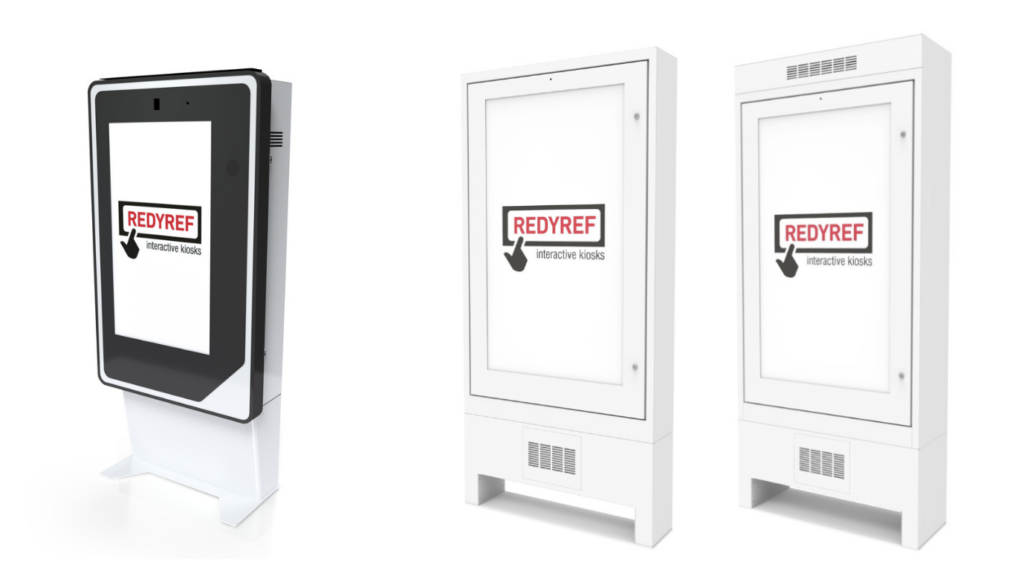
Digital Outdoor Kiosks: Use Cases and Opportunities
Wayfinding and Navigation
Electronic outdoor kiosks have become our trusted guides in navigating complex urban environments. They provide digital wayfinding assistance via real-time maps, directions, and points of interest to pedestrians and tourists, enhancing their experience and helping them find their way efficiently. These kiosks often feature interactive touchscreen displays, enabling users to input destinations, view transit schedules, and explore nearby attractions.
Parks and Recreational Areas
In parks and recreational areas, digital outdoor kiosks serve as valuable sources of information for visitors. They offer details about park amenities, event schedules, and trail maps. These kiosks play a crucial role in enhancing the overall park experience by ensuring that visitors are well informed and can make the most of their time outdoors. For those parks that charge admission, ticketing functionality can also be added, allowing users to pay and receive their tickets directly from the kiosks, both on paper, or via their mobile devices.

Retail and Advertising
Interactive outdoor kiosks have revolutionized the retail sector by providing 24/7 access to products and services. Retailers can showcase their offerings, accept orders, and process payments through these kiosks, offering convenience to customers even when traditional stores are closed. Additionally, these kiosks make great advertising platforms, displaying dynamic, eye-catching content that captures the attention of passersby.
Transportation Hubs
Transportation hubs, including bus stops, train stations, and airports, have embraced digital kiosks to provide travelers with essential information. Passengers can check schedules, track arrivals and departures, and plan their journeys more efficiently. These kiosks also play a role in promoting tourism by offering details about local attractions and accommodations.
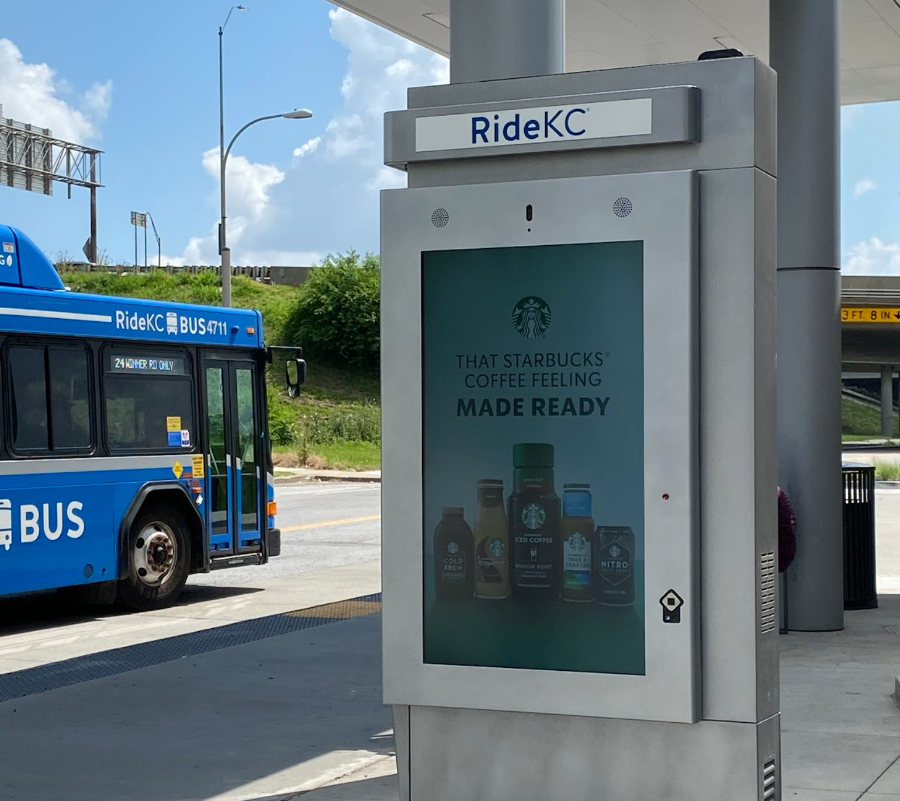
Tourism and Hospitality
In tourist-heavy areas, outdoor electronic kiosks serve as virtual concierges, assisting visitors with information about landmarks, historical sites, and local restaurants. These "smart city" kiosks offer a convenient way to access maps, historical context, and recommendations, making it easier for tourists to explore and enjoy their destinations.
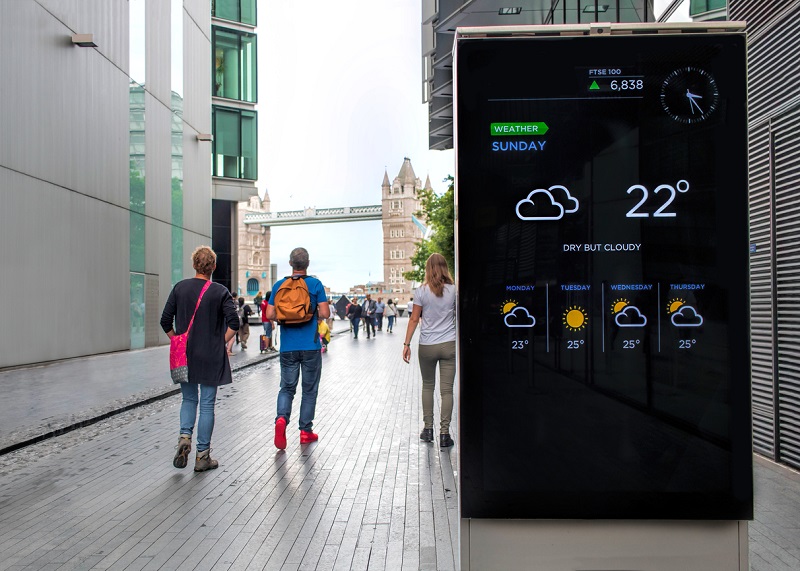
Emergency Alerts and Public Safety
Digital outdoor kiosks play a pivotal role in disseminating emergency alerts and public safety information. In the event of natural disasters, accidents, or other critical situations, these kiosks can quickly relay vital information to the public, helping people stay informed and safe.
Environmental Education and Awareness
Environmental organizations and government agencies utilize outdoor digital kiosks to raise awareness about local ecosystems, wildlife conservation efforts, and sustainability initiatives. These interactive kiosks often include educational videos, quizzes, and informative displays to engage the public in environmental issues.
Event Promotion
Cities and event organizers deploy touchscreen outdoor kiosks to promote upcoming events, festivals, and cultural happenings. These kiosks display event schedules, ticket information, and location details, encouraging attendance and community engagement.
Community Engagement and Feedback Collection
Outdoor kiosks offer a platform for community engagement and feedback collection. Local governments and organizations can use them to gather input from residents on various topics, such as city planning, public services, and community initiatives.
Art and Cultural Installations
Creative minds have harnessed the potential of electronic outdoor kiosks to showcase art installations and cultural exhibits. These kiosks can display digital art, historical archives, and cultural information, enriching the cultural fabric of public spaces.
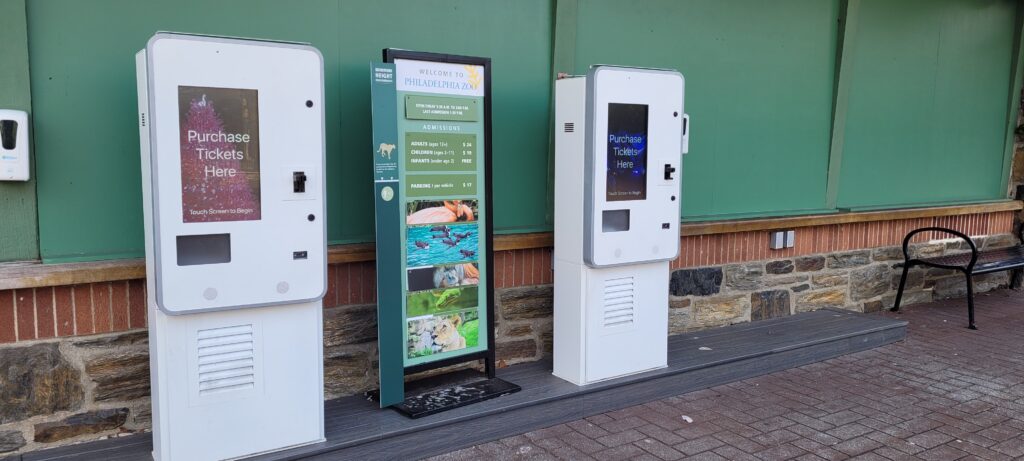
Interactive outdoor kiosks have evolved into versatile tools that seamlessly blend technology into outdoor environments. Their use cases span any number of business and public sectors, transforming the way we access information, services, and entertainment in public spaces. As technology continues to advance, we can expect outdoor digital kiosks to play an even more prominent role in our daily lives, enhancing the functionality and convenience of outdoor environments while fostering community engagement and enriching our overall experience of the world around us.
Outdoor digital kiosks represent a remarkable fusion of technology and environmental resilience, designed to offer information, services, and interactivity in outdoor settings. These versatile interactive kiosk machines have become pivotal components of modern urban landscapes. This article delves into how exactly kiosk manufacturers, like REDYREF, design and engineer outdoor digital kiosks, exploring the different considerations, challenges, and cutting-edge technologies that underpin their development.
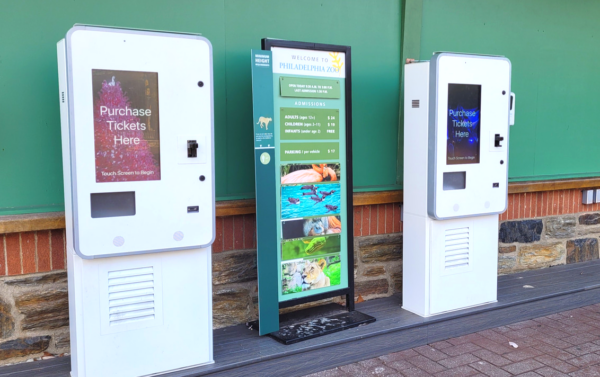
The Significance of Outdoor Digital Kiosks
Outdoor digital kiosks serve a multitude of purposes, from disseminating information in parks and recreational areas to providing retail solutions and wayfinding assistance in busy urban environments. What sets them apart from their indoor counterparts is their capacity to endure harsh weather conditions, temperature extremes, vandalism, and prolonged exposure to the elements. Therefore, engineering these requires careful planning and innovative engineering solutions to ensure their reliability and longevity.
Key Considerations in Designing Digital Outdoor Kiosks
Designing outdoor interactive kiosks requires a deep understanding of the environmental challenges they can face, and knowing exactly how those issues need to be addressed, ensuring they deliver seamless functionality and reliability in any outdoor application.
Weather Resistance and Enclosure Design
Electronic kiosks meant to be placed outdoors must be constructed with materials that can withstand a wide range of weather conditions, including heavy rain, snow, extreme heat, and cold. Enclosures should be hermetically sealed to protect internal components from moisture and humidity.
To further ensure weather resistance, kiosks often feature sloped roofs, protective overhangs, and reinforced seams to prevent water ingress.
Temperature Control Mechanisms
Maintaining the ideal operating temperature range is crucial for outdoor kiosks. Systems may incorporate internal heating and cooling mechanisms to ensure that internal components remain functional despite extreme weather fluctuations.
Durability and Vandalism Resistance
Outdoor kiosks are prime targets for vandalism and tampering. Design considerations include using robust materials, impact-resistant glass, and secure enclosures to deter damage and unauthorized access.
Sunlight Readability and Anti-Glare Technologies
High-brightness displays equipped with anti-glare and anti-reflective coatings ensure optimal visibility in direct sunlight, guaranteeing that users can access information comfortably.
Accessibility Compliance
Ensuring compliance with the Americans with Disabilities Act (ADA) is essential, allowing people with disabilities to access and utilize outdoor kiosks conveniently.
Robust Connectivity Options
Outdoor kiosks require reliable internet connectivity for real-time information updates and remote monitoring. These systems often incorporate multiple connectivity options, including Wi-Fi, cellular, and Ethernet.
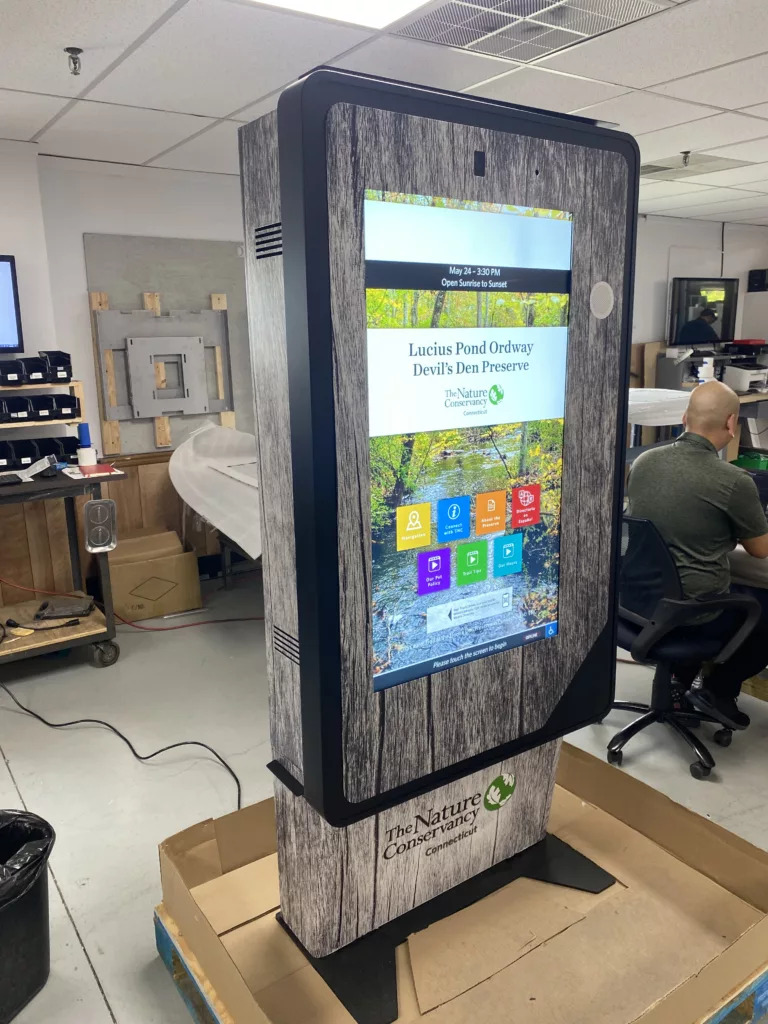
Technological Advancements in Outdoor Kiosk Design
Advancements in technology are driving the evolution of outdoor kiosks and expanding their capabilities into a new era of functionality and usability.
High-Resolution Interactive Touchscreen Displays
Interactive outdoor kiosks now boast high-resolution touchscreen displays that offer users a responsive and intuitive interface, making information retrieval and service access user-friendly.
Interactive Features for Enhanced User Engagement
Incorporating advanced interactive features like multi-touch support, gesture recognition, and voice commands enriches the user experience, making these digital kiosks more engaging and versatile.
Solar Power Integration for Sustainability
Some outdoor digital kiosk designs incorporate solar panels to generate power sustainably. Excess energy can be stored in batteries for use during periods of limited sunlight, reducing environmental impact and increasing autonomy.
Remote Monitoring and Management with IoT Technology
Internet of Things (IoT) technology facilitates remote monitoring and management of electronic outdoor kiosks. This allows for real-time diagnostics, content updates, and troubleshooting, minimizing downtime and maintenance costs.

Applications for Outdoor Digital Kiosks
Parks and Recreational Areas
Outdoor digital kiosks are invaluable in parks, offering visitors information about park amenities, maps, and upcoming events, as well as the ability to take payments and dispense tickets.
Wayfinding and Navigation in Urban Environments
In bustling cities, outdoor kiosks aid pedestrians and tourists in digital wayfinding, including navigating streets, discovering points of interest, and accessing public transportation information. In fact, "smart city" kiosks are becoming the norm in many places, offering everything from selfie stations to public wifi.
Retail and Advertising Solutions
Retailers leverage digital outdoor kiosks for advertising and self-service options. Customers can browse products, place orders, and make payments conveniently.
Tourism and Hospitality Industry
Outdoor kiosks play a pivotal role in the tourism sector by providing tourists with information about landmarks, local attractions, and nearby dining and accommodation options.
 The design and engineering of digital outdoor kiosks represent a dynamic field that continually evolves to meet the demands of the modern world. These kiosks have transformed outdoor spaces into hubs of interactive information and services, elevating the overall user experience in public areas, parks, and urban environments. As technology advances, interactive outdoor kiosks are poised to become even more integrated into our daily lives, offering valuable information and services while withstanding the rigors of outdoor environments. Innovations in design and engineering will continue to push the boundaries of what these kiosks can achieve, enhancing the way we interact with our surroundings.
The design and engineering of digital outdoor kiosks represent a dynamic field that continually evolves to meet the demands of the modern world. These kiosks have transformed outdoor spaces into hubs of interactive information and services, elevating the overall user experience in public areas, parks, and urban environments. As technology advances, interactive outdoor kiosks are poised to become even more integrated into our daily lives, offering valuable information and services while withstanding the rigors of outdoor environments. Innovations in design and engineering will continue to push the boundaries of what these kiosks can achieve, enhancing the way we interact with our surroundings.
Digital and interactive electronic elevator signage has given businesses a way to capitalize on what is truly a captive audience. These cutting-edge signs are dynamic and eye-catching, offering a wide range of information, entertainment, as well as opportunities for advertising and brand exposure. In this article, we will talk about some of the features and benefits of digital electronic elevator signage, explore the various types available, and explain why REDYREF is the ideal partner for businesses seeking to implement this innovative digital signage solution.

Features and Benefits of Digital Elevator Signs
Electronic elevator signs offer many features and benefits to businesses and passengers alike, including:
Captivating Content: Elevator signage captivates passengers with visually appealing content that goes beyond the mundane elevator ride. It offers news updates, weather forecasts, sports scores, and advertisements, transforming the elevator experience into an engaging journey. Additionally, this information can be updated remotely via a cloud-based system, making it easy and convenient to change out information quickly with only a moment's notice.
Enhanced Passenger Experience: Elevator signage enhances the passenger experience by providing valuable information and entertainment during their elevator ride. By alleviating boredom and delivering relevant content, it significantly improves passenger satisfaction.
Customizable Display: Digital and interactive electronic elevator signs can be customized to display specific content tailored to different floors, buildings, or target audiences. This flexibility ensures that the displayed information remains relevant, impactful, and resonates with the passengers.
Amplified Brand Visibility: Elevator signs are placed in front of a captive audience, making them ideal for brand exposure. By displaying advertisements, businesses can significantly increase brand recognition and recall among elevator riders. This unique advertising opportunity can leave a lasting impression on passengers.
Revenue Opportunities: While companies can certainly utilize digital signage for elevators to promote their own brand and services, many businesses also choose to sell ad space on these signs to other organizations who wish to reach a similar audience with their own messaging. This can offer an additional revenue opportunity for those who wish to utilize digital signage in this manner.
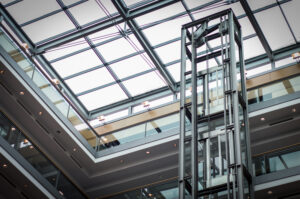
Types of Digital Elevator Signs
Digital elevator signage can be designed and manufactured with many different types of displays depending on their intended use. Some of these include:
LED Displays: LED displays are versatile and widely used for digital signage. With varying sizes available, they deliver vibrant visuals and can effectively showcase diverse content to engage passengers.
LCD Displays: LCD displays offer crisp image quality and are commonly used for elevator signage. While they may not be as bright as LED displays, they are highly effective for conveying information and captivating passengers.
Touchscreen Displays: Touchscreen displays enable passengers to interact with the content. These interactive elevator signs provide a unique and engaging experience, allowing users to explore additional information or customize their preferences while inside the elevator.
Industries Utilizing Digital Elevator Signage
Digital elevator signage has gained popularity across various industries and business settings due to its ability to display dynamic content, provide real-time information, and engage viewers with interactive features. Some examples of environments commonly utilizing electronic elevator signs include:
Office Buildings: Elevator signage in office buildings offers building information, news updates, and corporate communications, enhancing communication channels and engaging employees.
Shopping Malls: Elevator signage in shopping malls display advertisements, promotions, and store directories, effectively guiding shoppers and increasing foot traffic to specific businesses.
Hotels and Restaurants: Elevator signage in hotels and restaurants showcases amenities, event schedules, menus, and promotional offers, enhancing the overall guest experience and driving customer engagement.
Why REDYREF is the Right Kiosk Manufacturing Partner for Digital Elevator Displays
REDYREF is a leading kiosk manufacturer that has designed and deployed digital elevator signage for companies around the globe. Here's why so many businesses choose REDREF for their electronic elevator signs:
Expertise and Experience: With decades of experience, REDYREF boasts a team of skilled professionals who thoroughly understand the intricacies of digital signage. They can provide tailored solutions to meet your specific needs, ensuring optimal results.
Customization: REDYREF offers customizable options, allowing you to design and manufacture digital and interactive electronic elevator signage that aligns with your brand identity and specific requirements. This customization ensures that the signage solution perfectly represents your business.
Customer Satisfaction: REDYREF prioritizes customer satisfaction and has a proven track record of delivering successful projects and building lasting partnerships.
By implementing digital elevator signs, businesses can enhance passenger engagement, provide valuable information, and increase brand visibility. Elevate visitors' experience with REDYREF's digital and interactive elevator signage; contact us today to start the process and unlock the full potential of this transformative technology.
Self-service kiosks, also known as self-serve kiosks or terminals, empower customers to independently perform transactions, access information, and complete tasks. They have transformed customer interactions, offering convenience and efficiency across industries. In this article, we will explore the features, benefits, and diverse use cases of self-serve kiosks, highlighting their impact on businesses and users, in particular, how they enhance the customer experience, leading to greater satisfaction and loyalty.
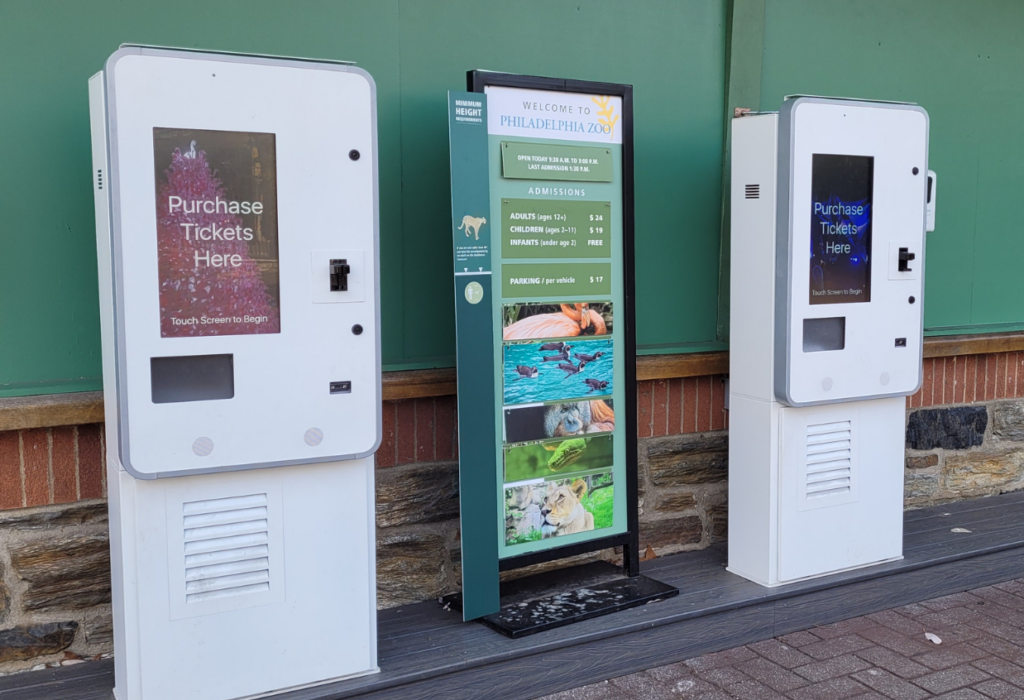
What Components Make Up a Self-Service Kiosk?
Self-service kiosks are cutting-edge interactive machines designed to empower users to perform transactions as well as access information independently. These technologically advanced kiosks feature intuitive interfaces, enabling users to effortlessly navigate through any number of different interactive options, and include specialized components such as:
- Touchscreen Displays: Self-service kiosks leverage user-friendly touchscreen displays, allowing users to interact directly with the interface. The touch-enabled screens respond to taps, swipes, and gestures, providing a familiar and intuitive way for users to engage with the kiosk. Larger kiosks generally use a display that is separate from the computer and other components, while smaller kiosks, such as those for simpler uses like queuing, may use a tablet or iPad, creating a more all-in-one solution.
- Kiosk Enclosure: Generally engineered and manufactured from stainless steel or ruggedized steel, depending on the environment in which the kiosk will be deployed. They are designed and fabricated based on the kiosk's use case, and may be rated for indoor or outdoor use.
- Kiosk Software: Self-service kiosk software is the "brain" that drives their functionality and performance. It enables seamless integration with hardware components, provides a user-friendly interface, and facilitates secure transactions. With features like data analytics and remote management, self-service kiosk software empowers businesses to deliver efficient and personalized interactive experiences to customers
- Hardware Components: Depending on the intended use case, self-service kiosks incorporate additional hardware components to enhance their functionality and cater to specific requirements. Some common hardware components found in self-service kiosks include:
-
- Barcode Scanners: Enable users to scan product barcodes or tickets for quick and accurate identification. This feature is especially beneficial in retail, transportation, and ticketing applications.
- Card Readers: Allow users to conveniently make payments using credit or debit cards, providing a secure and efficient transaction process. They are commonly found in retail, hospitality, and self-checkout kiosks.
- Printers: Enable users to receive physical receipts, tickets, or vouchers after completing transactions or registrations. This feature is especially common in industries such as retail, healthcare, and transportation.
- Cameras: Can be incorporated into self-service kiosks to support functionalities like ID verification, document scanning, or capturing images for identification purposes. This is particularly useful in applications such as airport check-ins, visitor registration, and self-service printing.
These hardware components complement the intuitive user interface of self-service kiosks, offering a seamless and efficient self-service experience to users across different industries.
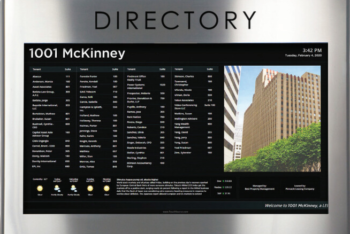
5 Features of Well-Designed Self-Serve Kiosks
- Intuitive User Interface (UI): Self-service kiosks prioritize user-friendly interfaces that guide customers seamlessly through the available options. The intuitive touchscreens feature clear instructions and simple navigation, ensuring that users can interact effortlessly with the kiosk, even without prior experience. The interface design takes into account user behavior and preferences, minimizing the learning curve and maximizing usability.
- Versatile Payment Options: One of the key advantages of self-serve kiosks is their ability to accommodate a wide range of payment methods, offering customers flexibility and convenience. Whether it's credit/debit cards, RFID, NFC, mobile wallets, or even cash, self-service kiosks enable users to make seamless transactions using their preferred payment method. This versatility ensures that customers can complete their purchases without hassle, enhancing their overall satisfaction.
- Real-Time Data and Information: Self-service kiosks excel in providing users with real-time information, enabling them to access up-to-date details about products, services, prices, promotions, and any other relevant data. Whether it's checking stock availability, comparing options, or gathering information about specific products, customers can rely on self-service kiosks to provide accurate and current information. This feature empowers customers to make informed decisions, fostering trust and enhancing their overall experience.
- Efficient Order Placement and Customization: In the food and beverage industry, self-service kiosks offer customers a streamlined and personalized ordering experience. These kiosks allow users to place their orders directly, bypassing long queues and minimizing waiting times. Moreover, self-service kiosks enable customers to customize their orders according to their preferences. From selecting ingredients, toppings, and condiments to specifying cooking preferences or dietary requirements, self-ordering kiosks ensure that each order is tailored to the customer's exact specifications. This level of customization not only increases customer satisfaction but also reduces order errors, as customers have full control over their preferences.
- Digital Signage Integration: Some self-service kiosks integrate dynamic digital signage capabilities, allowing businesses to display engaging and relevant content. By showcasing advertisements, promotions, or informative content on the kiosk's display, businesses can capture the attention of customers and enhance engagement. This feature serves as an additional revenue stream, as businesses can partner with third-party advertisers or promote their own products and services through the self-service kiosk's digital signage.
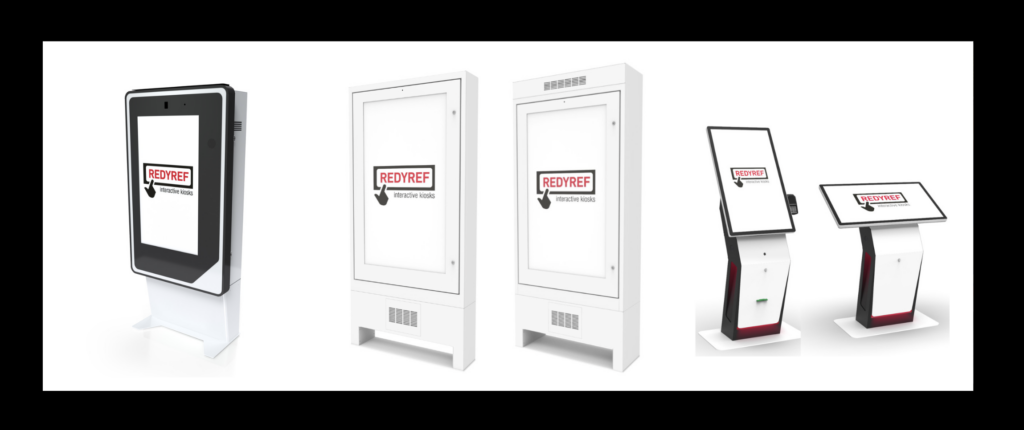
4 Benefits of Self-Service Kiosks
- Improved Customer Experience: The introduction of self-service kiosks revolutionized the customer experience by providing a quicker and more convenient way to complete transactions or access information. By reducing waiting times and allowing customers to control the pace of their interactions, these kiosk machines increase users' satisfaction levels. Customers appreciate the autonomy and efficiency that self-service kiosks offer, leading to increased loyalty and positive brand perception.
- Enhanced Operational Efficiency: Businesses can optimize their operations and allocate staff to more critical roles by offloading routine tasks to self-service kiosks. With self-service kiosks handling tasks such as checkouts, information lookup, or registrations, businesses can streamline processes, reduce bottlenecks, and improve overall efficiency. This not only saves time but also reduces labor costs and enables employees to focus on delivering higher-value services, such as personalized assistance or problem-solving.
- Increased Sales and Revenue: Self-service kiosks have the potential to significantly impact sales by creating upselling and cross-selling opportunities. Through targeted prompts or suggestive selling techniques integrated into the self-service kiosk interface, businesses can encourage customers to explore additional products or services. This approach leads to increased customer engagement, higher average transaction values, and ultimately, increased revenue. Self-service kiosks act as effective sales assistants, leveraging data-driven recommendations and enticing visuals to drive customer purchases.
- Data Collection and Analytics: One of the significant advantages of self-serve kiosks is their ability to collect valuable data and provide detailed analytics. By capturing customer behavior, preferences, and transaction patterns, businesses can gain actionable insights. These insights allow businesses to make data-driven decisions, optimize their operations, and personalize offerings based on customer trends. Through data analysis, businesses can identify areas for improvement, fine-tune their marketing strategies, and create targeted campaigns that resonate with their customer base.

4 Popular Self-Serve Kiosk Use Cases
- Retail and Hospitality: Self-service kiosks find extensive use in retail stores and hotels. They enable customers to perform self-checkout, access product information, book services, or complete room check-ins. These kiosks streamline processes, reduce queues, and enhance the overall customer experience by providing convenience and control over transactions and inquiries.
- Transportation Ticketing: Transportation hubs such as airports and train stations leverage self-service kiosks for various ticketing processes. Travelers can purchase tickets, check in, print boarding passes, and tag baggage using self-service kiosks. This automation expedites the passenger journey, reduces lines, and simplifies ticketing procedures, resulting in a more efficient and hassle-free travel experience.
- Healthcare and Pharmacy: Self-service kiosks in healthcare settings streamline administrative processes and enhance patient experience. Patients can check in for appointments, schedule future visits, request prescription refills, and access medical information through self-service kiosks. These kiosks reduce waiting times, improve workflow efficiency, and empower patients to take control of their healthcare interactions.
- Quick-Service Restaurants (QSRs): Quick-service restaurants are increasingly adopting self-service kiosks to enhance the ordering process. Customers can place their orders, customize their meals, and make payments directly through self-service kiosks. This automation speeds up service, reduces order errors, and empowers customers to tailor their dining experience according to their preferences, resulting in improved customer satisfaction and operational efficiency.
Self-service kiosks have become an indispensable tool for businesses across various industries, offering an efficient and personalized customer experience. With intuitive interfaces, versatile features, and benefits such as improved efficiency and increased sales, self-service kiosks continue to transform the way customers interact with businesses. By embracing this technology, organizations can meet the growing demand for self-service solutions and create a competitive advantage in today's digital landscape.
Interested in learning more about self-serve kiosks for your business? Contact REDYREF online today, or call 1-800-626-3603 for additional information.



























